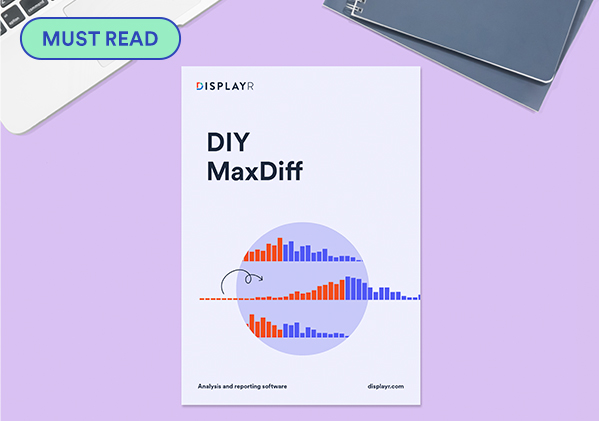

This is a guide for everything you need to know about MaxDiff. It covers the “what is?” and the “how to…” of different approaches to the analysis, from preference share to profiling latent classes and finally how to interpret the analysis. There are worked examples, shown in Displayr and R.
Introduction
What is Max Diff? Have you ever needed to know what your customers prefer? MaxDiff (otherwise known as Best-Worst Scaling) quite simply involves respondents indicating the ‘Best’ and the ‘Worst’ options out of a given set so that we can gain an understanding of consumers’ preference choices. This can be from how they feel about specific brands or products and to know which features make a difference and are of value to the consumer.
A Beginners Guide to MaxDiff MaxDiff is a research technique for measuring relative preferences.
How MaxDiff Analysis Works This post explains the basic mechanics of how preferences can be measured using the data collected in a MaxDiff experiment.
DIY MaxDiff
Make MaxDiff a piece of cake Quickly go from experimental design to analysis, to interactive report in one tool. Displayr automates all the painful manual steps and makes it easy to deliver best-in-class results, even for the novice.
The 4 easy steps that’ll make any good researcher proficient at MaxDiff This webinar is for market researchers and consumer insights people who analyze data (from novice to expert).
11 Tips for your own MaxDiff Analysis This post shares 11 tips to help researchers be self-sufficient in MaxDiff analysis.
DIY MaxDiff eBook This ebook will take you from generating experimental designs to conducting advanced Hierarchical Bayes analysis.
Interactive Tutorials
Creating an Experimentation Design for MaxDiff This interactive tutorial demonstrates how to create a MaxDiff Experimental Design
Analyzing MaxDiff Data This interactive tutorial demonstrates the range of purpose-built tools for analyzing the data from MaxDiff experiments available in Displayr.
Experimental Design
How to Create a MaxDiff Experimental Design in Displayr This post describes how you can create and check the design yourself.
Advanced MaxDiff Experimental Designs A MaxDiff experimental design creates multiple lists of alternatives to be shown to respondents in multiple questions.
Pairwise Balanced MaxDiff Designs This post gives some background on how MaxDiff designs are created, including a new method for making multiple version designs that are pairwise balanced.
How To Check Experimental Design This post explains the basic process followed when doing a rough-and-ready check of the experimental design.
Data File Formats
Custom Data Files - Survey Gizmo MaxDiff This QScript makes it possible to analyze Alchemer (formerly Survey Gizmo) MaxDiff data in Displayr.
MaxDiff Data File Layouts There is no standard way of laying out the data from MaxDiff experiments. The following descriptions encapsulate some of the common ways.
Statistical Analysis
How to Analyze MaxDiff Data in Displayr This post discusses a number of options that are available in Displayr for analyzing data from MaxDiff experiments.
Setting Up a MaxDiff Experiment as a Ranking There are some more 'exotic' types of analysis of MaxDiff data where it is useful to have the data set up as a Ranking Structure.
Counting Analysis of MaxDiff Data This post explains how to do Counts analysis of MaxDiff data.
Comparing MaxDiff Models and Creating Ensembles in Displayr There are a variety of different models available in Displayr to perform MaxDiff analysis. This post describes how to easily compare the models. It also demonstrates how to create an ensemble that combines the models and potentially improves prediction accuracy.
The Accuracy of Hierarchical Bayes When the Data Contains Segments This post explores the implications of using Hierarchical Bayes with data that contains segments.
Using Hierarchical Bayes for MaxDiff in Displayr This post describes how to run Hierarchical Bayes for MaxDiff in Displayr, and explain the options and outputs available.
Checking Convergence When Using Hierarchical Bayes for MaxDiff This post discusses technical information about how to check for convergence in a Hierarchical Bayes MaxDiff model.
Comparing Tricked Logit and Rank-Ordered Logit with Ties for MaxDiff This post compares two ways in which MaxDiff data is treated in analyses such as latent class analysis and Hierarchical Bayes.
Using Cross-Validation to Measure MaxDiff Performance This post compares various approaches to analyzing MaxDiff data using a method known as cross-validation.
Comparing MaxDiff Results from Different Packages This post lists the main reasons why you may get different results with different packages.
MaxDiff Mixture Models This post discussed the main mixture models used to analyze the MaxDiff experiments.
Anchored MaxDiff Anchored MaxDiff experiments supplement standard MaxDiff questions with additional questions designed to work out the absolute importance of the attributes.
Case Studies
MaxDiff Analysis in Displayr, a Case Study This case study illustrates an advanced analysis of experimental data in Displayr.
Commander-in-Chief MaxDiff An alternative to PowerPoint, story-style dashboard showing an analysis of what Americans desire in their Commander-in-Chief.
Learn more
If you can't find something you can always ask the technical support team, who love to help. Just email [email protected]. Happy learning!




